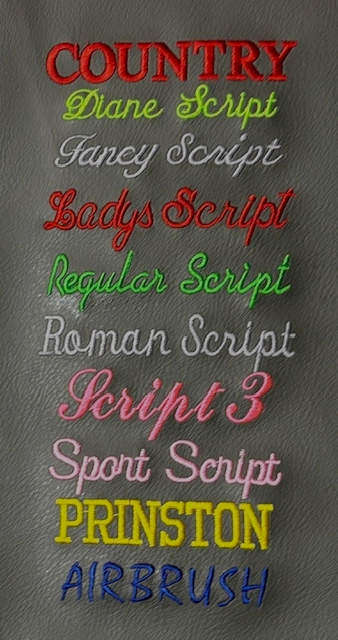Customized Mugs with Customized Embroidery Styles for a Distinct Gift
Wiki Article
The Art of Customized Needlework: Unlocking the Secrets to Creating Unique and Unforgettable Layouts
The secrets to creating custom embroidery layouts that astound the eye and leave a long-term impact lie in a fragile equilibrium of method, imagination, and interest to detail. As we delve into the globe of custom-made needlework, we uncover the nuanced interaction in between thread selection, sew complexity, and style personalization that boosts a plain garment to a work of art.Choosing the Right Needlework Threads
When picking embroidery strings, what essential variables should you think about to make certain the most effective outcomes for your customized styles? The choice of embroidery string is essential in establishing the final end result of your stitched style. One of the main factors to consider is the material of the thread. Various products such as cotton, polyester, rayon, and silk provide differing degrees of sheen, toughness, and texture. It is necessary to pick a thread material that matches the textile you are embroidering on and lines up with the wanted appearance of the design.
Thicker threads can include measurement and structure to your design, while finer strings are excellent for detailed details and small message. In addition, thinking about the color fastness and washability of the string is critical to make sure that your custom-made designs keep their top quality and vibrancy over time.
Exploring Various Stitch Methods
To delve right into the world of 'Exploring Various Stitch Methods', one should grasp the details and nuances that each sewing technique brings to the art of needlework. Different stitch strategies not just add aesthetic passion however also add to the general texture and measurement of the style. One popular stitch strategy is the satin stitch, which entails carefully stuffed parallel stitches to produce a smooth and shiny surface area, suitable for completing forms and creating vibrant lays out.On the other hand, the backstitch is a functional method frequently utilized for outlining and including great details. It entails stitching backwards to develop a solid line of embroidery. In addition, the French knot stitch adds a responsive component to styles, excellent for producing distinctive accents like blossom centers or ornamental touches.
Discovering different stitch techniques enables embroiderers to have fun with light, shadow, and depth within their styles, boosting the visual charm and creative top quality of their needlework projects. By grasping different sewing methods, one can unlock countless opportunities for creating distinct and unforgettable personalized needlework pieces.
Incorporating Personalized Design Aspects
Having actually discovered the intricacies of different stitch methods such as the satin stitch, backstitch, and French knot, the focus now shifts towards integrating tailored layout elements in custom embroidery projects. Customized layout components play an essential function in making embroidery jobs genuinely unique and memorable. One way to integrate personalization is by adding initials, names, or considerable days to the design. This not only includes an individualized touch yet likewise improves the sentimental worth of the embroidery piece.Another means to include personalized design components is by including icons or themes that hold special definition to the recipient or reflect their passions and character. For instance, including a preferred blossom, pet, or hobby-related sign can make the embroidery style more purposeful and customized. In addition, selecting shades that resonate with the recipient or line up with the intended theme can additionally enhance the customization of the needlework project.
Understanding the Art of Color Sychronisation

One trick element of shade sychronisation is recognizing color concept. This consists of knowing exactly how different shades interact with each various other, the emotions they communicate, and how they can be integrated to develop aesthetically appealing styles. By using color concept principles, embroiderers can develop harmonious color schemes that improve the total look of the style.
Additionally, paying interest to comparison is crucial in shade control. Using contrasting shades can assist particular components of the design pop, enhance readability, and create a visually vibrant needlework piece. By grasping the art of shade coordination, embroiderers can raise their layouts and develop memorable items that reverberate with customers and viewers alike.
Enhancing Structure With Advanced Needlework Stitches
French knots, for example, are best for including small, increased dots to your layout, imitating the appearance of beads or producing a distinctive surface. Bullion knots, on the other hand, can be utilized to create twisted, ropelike elements that include a lavish feel to the embroidery. Seed stitching entails little, scattered stitches that can fill in areas with a multicolor structure, while turkey job develops fluffy, dimensional accents similar to pet fur or foliage. Trying out these innovative embroidery stitches enables you to press the borders of traditional school uniforms embroidery and create really unique and aesthetically enticing textures in your layouts.
Final Thought
Finally, the art of customized embroidery entails a mix of selecting the best threads, exploring numerous stitch methods, integrating customized design elements, understanding color coordination, and boosting structure with sophisticated stitches. By comprehending and carrying out these crucial elements, embroiderers can develop special and memorable layouts that display their imagination and ability. Needlework lovers can unlock the keys to producing gorgeous and bespoke items that stand apart and leave a lasting impact.Report this wiki page